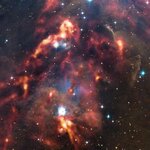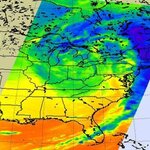Aerospace

A new image from the Atacama Pathfinder Experiment (APEX) telescope in Chile shows a beautiful view of clouds of cosmic dust
nebula NGC 1999
in the region of Orion. While these dense interstellar clouds seem dark and obscured to visible-light observations, APEX’s LABOCA camera can detect the heat glow of the dust and reveal the hiding places where new stars are being formed. But one of these dark clouds is not what it seems.
In space, dense clouds of cosmic gas and dust are the birthplaces of new stars. In visible light, this dust is dark and obscuring, hiding the stars behind it. So much so…

Low pressure areas that dropped more than a foot of snow in some Midwestern states have prompted many warnings and weather advisories. Satellite data recently got a look at a major snowstorm.
On Dec. 21st, 2012, at 0729 UTC (2:29 a.m. EST), the Atmospheric Infrared Sounder (AIRS) instrument that flies aboard NASA's Aqua satellite captured an infrared image of the massive low pressure area that caused a major snowstorm in the Midwest and beyond.
The AIRS infrared image was false-color enhanced to show temperatures. In the false color image, the darkest blue and purple areas indicate the…

A team of astronomers have measured an excess of X-ray radiation in the first few minutes of collapsing massive stars, which may be the signature of the supernova shock wave first escaping from the star - new evidence that X-ray detectors in space could be the first to witness new supernovae that signal the death of massive stars.
Gamma-ray bursts are known to arise in stellar deaths because coincident supernovae are seen with ground-based optical telescopes about ten to twenty days after the high energy flash. The true moment of birth of a supernova, when the star's surface…

If you looked at the "Black Marble" images of Earth at night released by NASA and the National Oceanic and Atmospheric Administration this week, you may have noticed bright areas in the largely uninhabited western part of Australia.
What's the story?
The night light observed by the Suomi NPP satellite images comes from wildfires. In those bright areas of western Australia, there are no nearby cities or industrial sites but there were fires in the area when Suomi NPP made passes over the region.
The extent of the night lights in this area is also a function of composite imaging.…

The Gamma-ray Burst Monitor (GBM) on NASA's Fermi Gamma-ray Space Telescope is now 10 times better at catching the brief outbursts of high-energy light, known as terrestrial gamma-ray flashes (TGFs),mysteriously produced above thunderstorms.
Terrestrial gamma-ray flashes last only a few thousandths of a second but their gamma rays rank among the highest-energy light that naturally occurs on Earth. The enhanced GBM discovery rate helped scientists show most TGFs also generate a strong burst of radio waves, a finding that will change how scientists study this poorly understood phenomenon…

How do you test the effects of weightlessness in space without risking lives and a lot of money?
Use a bed. People in bed with their heads 6° below the horizontal for long periods causes their bodies to react in similar ways to being weightless and so bedrest studies are being used to answer questions on how our bodies adapt to living in space and and even how our bodies adapt to growing old. Like Tang and pens that write upside down, findings from bedrest studies may apply directly to people on Earth.
In an ESA project, 12 volunteers are about to spend 21 days in bed, lying with their heads…

Move over Flight of the Bumblebee. Hello Flight of the Butter Tubs.
That’s what you could call the daring 12,000 mile journey that Australian pilot Jeremy Rowsell is planning for early next year, when he will fly a single engine plane from Sydney to London on fuel that’s neither gasoline, kerosene nor any other traditional aircraft propellant.
Oh, it must be aviation biofuel? Or perhaps it’s some of that discarded cooking oil that has given lift to a few recent aerial stunts?
Wrong!
Rowsell and his partners are cooking up 4,000 liters of liquid energy by melting down discarded plastic – the…

In January, 2005, ESA’s Huygens probe bounced, slid and wobbled its way to rest for 10 seconds after touching down on Saturn’s moon, Titan. As you can imagine, that tells scientists quite a bit about the nature of that moon’s surface.
They reconstructed the chain of events by analyzing data from a variety of instruments that were active during the impact, in particular changes in the acceleration experienced by the probe. The instrument data were compared with results from computer simulations and a drop test using a model of Huygens designed to replicate the landing and the analysis revealed…

Early in the morning of September 12th the Dark Energy Camera (DECam), the most powerful sky survey instrument yet built, mounted on the Victor Blanco Telescope at the Cerro Tololo Inter-American Observatory in Chile recorded its first images of a southern sky spangled with galaxies.
Galaxies up to 8 billion light years away were captured on DECam’s focal plane. DECam was built by the Dark Energy Survey (DES) collaboration based at the Fermi National Accelerator Laboratory. A photometric imaging camera, it measures the amount of light in various colors from astronomical…

I've been feeling a bit inspired about our prospects in space, lately. Foremost (of course) by the incredible competence displayed by the makers of the Curiosity probe that landed on Mars, last week, and the JPL controllers and the citizenry that backed such a wonderful venture.
If we must preen about "american exceptionalism" then let it be about Curiosity - and other admirable traits - that truly are exceptional. Also recently, I met one of the great astronauts of our time, Story Musgrave, at the World Science Fiction Convention in Chicago, where another topic was the…